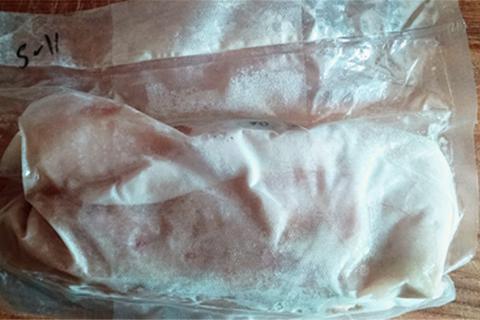
The fish you see in the photo is a halibut I caught in 2011. I found that package recently when I was organizing all the fish and game in my chest freezer. Somehow it had migrated to the bottom of the pile, buried under a couple of plucked geese and five pounds of alligator meat.
As you can see, it is none the worse for wear and, when I thaw it out in the next week or so, should taste almost as good as it was when freshly caught.
Fish is Most Prone to Deteriorating Under Frozen Storage
Even the mighty halibut is delicate in flesh and, when poorly packaged, can quickly and easily go from delicious to disgusting.
Enemy No. 1 when it comes to freezing fish, or anything, is cold air. The farther the temperate drops below 32 degrees the drier the air becomes and cold, dry air dehydrates meat and the longer it stays in contact with it, the more the meat deteriorates.
In reality, freezer burn is not a burn but an extreme drying process. It should be avoided at all costs.
As evidenced by the photo, one of the best ways to prevent exposure to cold, dry air is by vacuuming all the air out of the storage package and sealing out the elements. The best vacuum sealers, like the Cabela's Commercial-Grade models I used to seal this halibut, not only remove the air from the bag, but also create a reliable seal.
It also helps to use the best quality vac-seal bags you can find. The thicker they are the better they stand up to punctures that can happen when stacked among other hard-frozen items in the freezer, or during transport home.
If you do not own a vacuum sealer, there are a few other methods for preserving fresh fish. The National Center for Home Food Preservation recommends the following to methods:
Ice Glaze: Place unwrapped fish in the freezer to freeze. As soon as it is frozen, dip fish in near-freezing ice water. Place fish again in the freezer a few minutes to harden the glaze. Take fish out, and repeat the glazing until a uniform cover of ice is formed. Wrap the fish in moisture-vapor resistant paper or place in freezer bags, label and freeze.
Water: Place fish in a shallow metal, foil or plastic pan; cover with water and freeze. To prevent evaporation of the ice, wrap the container in freezer paper after it is frozen, label and freeze.
Both of these methods work well, and freezing in a block of ice was the preservation method of choice for most anglers until vacuum-sealing came along.
After my experience with this particular halibut filet, I think I will stick with my Cabela's Commercial-Grade Vacuum Sealer, but do not be afraid to test the other methods listed here.
- 2247 views

